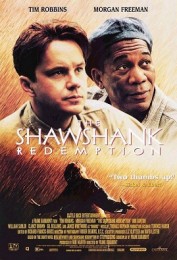From Flop to Fave: How “Shawshank” Hit it Big, Eventually

It’s hard to believe but when The Shawshank Redemption came out in 1994, it was DOA. That’s right! No one cared about poor, gangly Andy Dufresne, the banker sent to prison for supposedly killing his wife, or Red, the grizzled old prisoner who befriended him. No one cared that American institution Stephen King wrote the script, based on his novella, or that Frank Darabont, who would go on to create “The Walking Dead,” directed. No one wanted to see a drab downer set in the ’40s about mistreated criminals without any ladies or movie stars in it, not when they could watch Forrest Gump instead.
Ah, how the tables have turned. The Wall Street Journal has put together a delightful piece about how Shawshank started to make money — and then never stopped:
“It’s an incredible moneymaking asset that continues to resonate with viewers,” said Jeff Baker, executive vice president and general manager of Warner Bros. Home Entertainment theatrical catalog. Warner Bros. wouldn’t say how much money it has gleaned from “Shawshank,” one of 6,000 feature films in a library that last year helped generate $1.5 billion in licensing fees from television, plus an additional $2.2 billion from home video and electronic delivery, according to SEC filings. …
“Shawshank’s” last 20 years offer a guided tour through the myriad and evolving revenue streams of the entertainment business. After grossing $28 million at the box office in North America and another $30 million overseas, it went on to the video rental market and by the end had made about $80 million in sales, Warner Bros’ Mr. Baker said. Television licensing fees to date likely have surpassed U.S. box-office receipts, according to a person familiar with the studio’s finances. As a general rule, studios pocket about half of box-office revenue (less than that overseas), two-thirds of home entertainment sales, and almost all of TV licensing revenue. Based on those margins, “Shawshank” has brought in more than $100 million.
In fact, it became one of the highest-grossing video rentals of all time.
More Shawshank trivia: Morgan Freeman initially protested against the idea of taking the role of Red, saying he couldn’t play an Irishman. But Darabont chose him over Clint Eastwood, Harrison Ford, Paul Newman, and Robert Redford, and in the process helped cement Freeman’s status as one of Hollywood’s most reliable stars. No sore loser, Clint Eastwood went on to cast Freeman in Million Dollar Baby and other films. Meanwhile, Tom Hanks couldn’t regret passing up the chance to play Andy Dufresne too much, since he won the Oscar for the role he took instead.
Also, “Mr. King never cashed the $5,000 check Mr. Darabont sent him for the right to turn his story into a movie. Years after “Shawshank” came out, the author got the check framed and mailed it back to the director with a note inscribed: “In case you ever need bail money. Love, Steve.”
Other films that took a while to catch on with audiences, despite their evident charms, include such classics of the American canon as The Wizard of Oz, It’s a Wonderful Life, Blade Runner, Bonnie and Clyde, Bringing Up Baby and Citizen Kane. True story! The cream rises to the top, I guess, but not always immediately, and not without help.
Support The Billfold
The Billfold continues to exist thanks to support from our readers. Help us continue to do our work by making a monthly pledge on Patreon or a one-time-only contribution through PayPal.
Comments